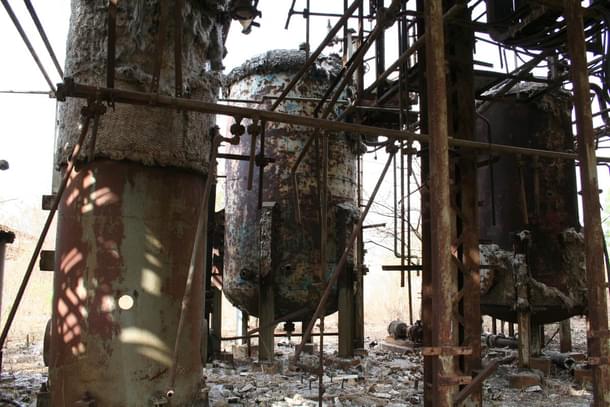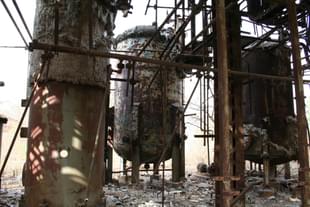News Brief
Bhopal Gas Tragedy: Trial Incineration Of Toxic Waste Begins In Madhya Pradesh's Pithampur
Kuldeep Negi
Mar 02, 2025, 01:36 PM | Updated 01:36 PM IST
Save & read from anywhere!
Bookmark stories for easy access on any device or the Swarajya app.


The trial incineration of 10 tonnes of hazardous waste from the defunct Union Carbide Bhopal factory began on Friday (28 February) at Re Sustainability’s treatment, storage, and disposal facility (TSDF) in Pithampur in Madhya Pradesh's Dhar district, Indian Express reported.
Officials confirmed that air quality and other environmental parameters remained within normal limits so far.
In January, 337 metric tonnes of toxic waste was transported from Union Carbide’s defunct Bhopal factory to Pithampur, following a directive from the Madhya Pradesh High Court.
However, local protests against the incineration process caused delays in initiating the trial.
Acting on the orders of the Jabalpur bench of the MP High Court, the trial incineration commenced on 27 February, starting with the unloading of five types of hazardous waste from five of the 12 containers.
The materials were then moved to a designated storage area at the private facility, which is situated about an hour's drive from Indore.
The trial incineration process is to be carried out in three phases, with 10 metric tonnes of waste being burned on 27 February, 4 March, and 10 March.
The second and third trials will reportedly proceed only after verifying that the first round had no adverse effects and the emissions are within prescribed values of ambient air quality standards.
Officials from the Madhya Pradesh Pollution Control Board (MPPCB) and the Central Pollution Control Board are overseeing the incineration process, and are following a standard operating procedure, prepared based on the Hazardous Substances Management Rules.
Senior officials from the Madhya Pradesh Police, Dhar district administration, and Re Sustainability Ltd are present at the site during the trial.
The trial started with a blank or dry run of the incinerator on 27 February.
The incinerator has two chambers—one reaching 850 degrees celsius and the other 1,150 degrees celsius. The dry run lasted over 12 hours.
"At 3 pm on Friday, we began feeding the actual waste into the incinerator,” Shrinivas Dwivedi, regional officer, MPPCB, was quoted as saying by The Indian Express.
According to Dwivedi, during the dry run of the incinerator, a feed of the hazardous waste was prepared by mixing it with lime to optimise its calorific value.
“We prepared 9 kg packets and they are being fed into the incinerator at a rate of 135 kg/hour,” he said.
In the subsequent process, the flue gases produced during the waste burning will be sprayed with a solution of sodium sulphide and a multicyclone will collect dust particles.
This trial will go on for the next 72-74 hours and so far, all the pollutants emitted are well within the permissible prescribed range, Dwivedi added.
“At present, the work is being done following a SoP created by the MPPCB. Ten metric tonnes of waste will be incinerated on three different occasions," Dhar Collector Priyank Mishra was quoted as saying by IE.
"The minimum number of containers that were required to be opened to start the trial were five as the different kinds of waste were stored in different containers," he added.
The waste includes 162 metric tonnes of excavated contaminated soil, 92 metric tonnes of naphthol and carbaryl (Sevin insecticide), 54 metric tonnes of semi-processed pesticide waste, and 29 metric tonnes of reactor residue.
Following criticism from the Madhya Pradesh HC over state government's inaction, toxic waste was moved to Pithampur for disposal.
The waste brought to Pithampur was production linked waste that was dumped on the factory floor and premises and initially bundled and packed away on the plant site in 2005.
The Supreme Court had, on February 27, refused to interfere with the order of the MP High Court to transfer and dispose of the waste.
The bench of Justice BR Gavai and Justice AG Masih had also refused to stay the test process.
The Bhopal Gas Tragedy, which occurred during the night of 2-3 December 1984, involved a catastrophic leak of methyl isocyanate (MIC) gas from the Union Carbide facility resulting in the deaths of at least 5,479 people and left thousands with severe health repercussions, marking it as one of the deadliest industrial disasters in history.
Also Read: India Has Nearly Eliminated Extreme Poverty, Sharp Reduction In Inequality Over Last 12 Years: Study
Kuldeep is Senior Editor (Newsroom) at Swarajya. He tweets at @kaydnegi.





